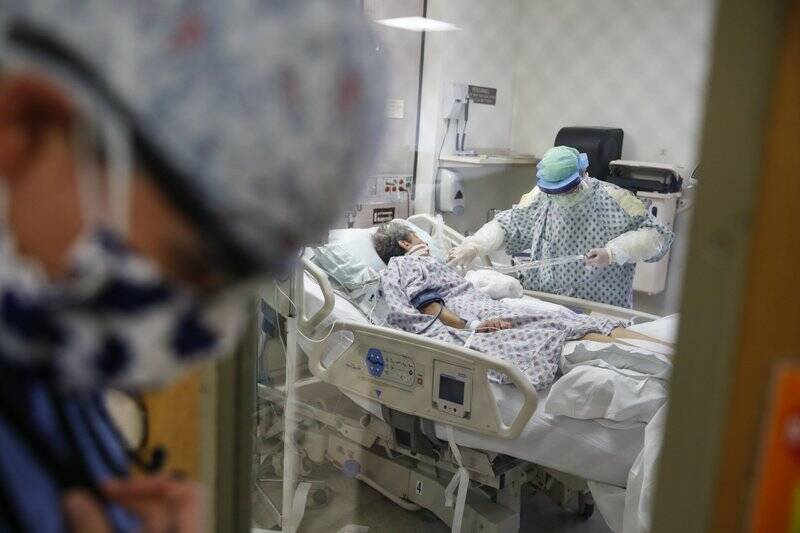In a year that saw thousands of more deaths than expected across the state, COVID-19 emerged as Alaska’s third-leading cause of death for 2021, according to an Alaska Department of Health and Social Services report.
The report details the breakdowns of causes, numbers, regions and demographics of the deaths, which affected nearly every group of Alaskan residents.
“The way that we modeled is using historical data. We took historical data from the vital records system prior to 2020,” said Rosa Avila, a public health scientist with DHSS and deputy chief of health analytics and vital records for the department. “We used that data to model for what we expected to see in a typical year.
[Packed houses, back to back: GLITZ a roaring success]
According to the model used to predict death rates, Alaska was forecast for 4,773 total deaths in 2021. Instead, it saw 6,194. Of those 1,421 deaths above the predicted total, only 742 were from COVID, according to state data — almost every other death category in the top 10 deaths came in ahead of predictions, some considerably more, such as chronic liver disease cirrhosis, which had 63 excess deaths out of the 186 total reported.
The 2021 data is still considered preliminary, Avila said.
“I don’t expect huge changes, but I do expect changes,” Avila said.
To find statistically significant differences, the team preparing the report looked at the report and then at amounts of deaths that varied from the expected count by a certain rate.
“To try to create the model, we did a lot of testing of different models,” Avila said. “We looked at what the CDC has done and did something very similar to them. We also took into account not having complete data.”
Leading causes of death for the state ended up being malignant neoplasms (cancer), heart disease and COVID-19.
“With our preliminary data of the leading mortality for 2021 showed it’s our third-leading cause of death,” Avila said. “We’ve always had cancer and heart disease being our top two. COVID as the underlying cause of death surpassed accidental deaths.”
COVID-19 also ended up contributing the elevated death counts in other less direct ways, Avila said. Strains on logistical chains for medical supplies, beds being taken up by COVID-19 patients leading to people with other conditions not getting admitted and subsequently dying, and people being afraid of going into the emergency room until it was too late to save them all likely contributed to higher death counts, Avila said.
“All of those things are really hard to measure and pinpoint what the effect on mortality was,” Avila said. “There’s so many other pathways to mortality that could have been affected then just getting COVID-19.”
This year will hopefully see less excess deaths as better information and a hopefully-abating pandemic lessen the factors that pushed casualty numbers up, Avila said.
“I’m hoping because we have more tools to utilize, we’re not going to see such large numbers of excess deaths,” Avila said. “But that doesn’t mean there won’t be any. We have more resources to mitigate a high burden on mortality.”
Looking local
At Bartlett Regional Hospital, the numbers were a little different, according to public information officer Erin Hardin. The top three causes of death for the past two years were sepsis, heart disease and cancer, Hardin said, based on information BRH staff had put together.
BRH doesn’t model deaths, as it’s more of a state-level function, Hardin said, but the hospital did see an increase in deaths in 2020-2021, at 96 deaths, set against the previous two year period of 2018-2019, at 85 deaths. Of those deaths since the beginning of the pandemic, 13 people had COVID-19, though Hardin said it wasn’t the underlying cause of death, but a contributing cause.
“We did not see an increase in the types of leading underlying causes of death. We did see an overall increase in the number of deaths as compared to the two years prior,” Hardin said. “We did not experience COVID-19 as a significant cause of, or contributor to, mortality at BRH.”
Other areas in the state had higher excess deaths than Juneau, according to the DHSS data, both in absolute numbers and in rates.
“Anchorage had the most excess deaths at 493,” Avila said. “The region that had the highest rate of excess deaths was the Mat-Su.”
Certain parts of the population were also host to more excess deaths than others, Avila said.
“The Alaska Native and American Indian population was hit really hard,” Avila said. “We did see really high excess deaths for Alaska Natives and American Indians in 2020. That disparity still exists.”
Avila said she hoped technology and best practices will help continue to drive the excess numbers back down.
“We’re not completely in the clear. We’re still learning things all the time and new medicines and technology are coming out all the time,” Avila said. “All of those things will help us to normalize those trends one day.”
• Contact reporter Michael S. Lockett at 757-621-1197 or mlockett@juneauempire.com.

